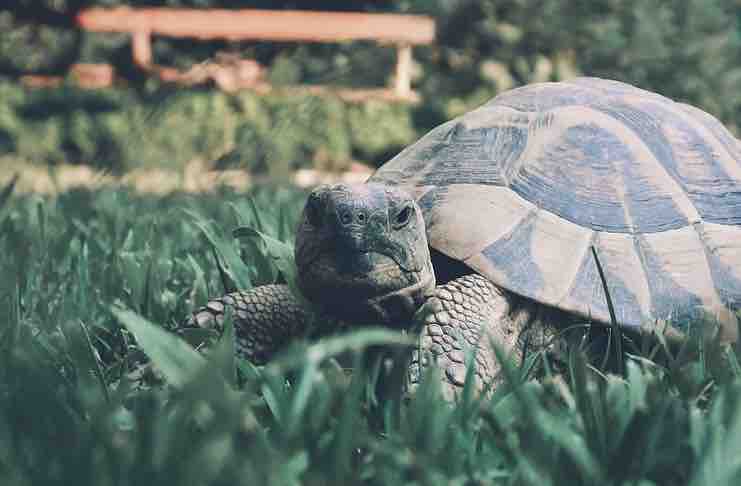Although some people are content to stuff their tortoises into an entirely too-cramped indoor space and habitat, they should really know better.
Tortoises, like many other less-conventional pets, require a sizable amount of space to stay healthy and safe in your care—in other words, they ought to be kept outside in some way, shape, or form.
But how do you safely keep a tortoise outdoors? Read on to learn more about creating the ideal fenced-in enclosure for your tortoise.
Threats to Your Outdoor Tortoise
When considering the best reasons why you want to build a safe enclosure for your outdoor tortoise, it’s helpful to consider what can go wrong.
This is because, despite our firm belief that tortoises should be kept outside, it can be better to keep them inside in certain situations.
For example, when your tortoise is still tiny or growing, it doesn’t need all that much space. You can keep them inside and protected until the time comes when they need more space to stretch their shells.
However, if your tortoise is already big enough that keeping them inside is no longer possible or even desirable, keep the following dangers in mind while you’re still in the concept stage of your tortoise’s new home:
- Someone Can Cause Your Turtle Harm – That is, if they’re not properly protected, of course. It’s not unheard of to have a neighbor kid lose their ball in your backyard, go looking for it, and then accidentally injure your turtle in the process. So, plan on keeping your turtle in a place where they won’t get accidentally stepped on.
- Your Turtle Might Not Be a Strong Swimmer – This one goes without saying. Got a pool? Better keep it barricaded off from wherever your turtle’s going to be, then. Otherwise, tragedy can ensue.
- Your Turtle Can Escape and Get Into an Accident – If you get in a car accident, a car accident attorney can help you negotiate an injury settlement through the insurance claims process. Your tortoise? Not so much. Plan on building your fence out properly so your outdoor tortoise doesn’t go full MacGyver and end up playing frogger in oncoming traffic.
Simply put, knowing the dangers your tortoise could face in an outdoor environment is the best way to adequately prepare.

Sizing Your Outdoor Tortoise Enclosure
What is the appropriate size for your tortoise enclosure?
This really depends on two main factors: the amount of space at your disposal and the size of your tortoise.
For hatchling tortoises, a space that’s roughly 4 feet x 8 feet is normally sufficient. For large adult tortoises, such as Sulcatas, Aldabras, or even Hermanns, 10 feet x 20 feet should be considered the minimum.
Of course, when it comes to making your tortoise healthy, happy, and safe in their enclosure, more space is always better than less. Some other factors to keep in mind include the number of tortoises you own, as well as the presence of trees or other obstacles.
Materials You Can Use to Build Your Enclosure
You can build your enclosure with pretty standard-fare materials from your local hardware store.
Some examples of materials you may need—or might just like to have—include:
- Wood
- Brick
- Concrete
- Metal
- Stones or rocks
In reality, enclosures made of wood, chain-link fencing, or even cinder blocks held together by concrete are all popular, and economic, choices.
Considerations for Building the Enclosure
One of the most important considerations for building your tortoise enclosure is safety and structural integrity. Tortoises are known diggers, which is something you should be aware of when erecting the walls of the enclosure.
Because of this, the walls of your tortoise enclosure should be buried at least 12 inches below ground level to prevent any burrowing out by your reptilian friend.
Furthermore, make sure to poke some drainage holes every few feet or so along the base of your enclosure’s walls to allow for fast and easy water runoff.
Decorating Your Tortoise’s Enclosure
If housing more than one tortoise in your enclosure, decorations, such as bushes, can be vital additions to mitigate the possibility of any territory wars or other aggressive behavior.
Also, making sure your enclosure has access to water (shallow, not pool depth), a feeding/bathroom area, plants for grazing, and a shady place for your tortoise to regulate its body temperature are also important things to consider.
In terms of fun, you can tap into your tortoise’s natural predilection for burrowing by including a pre-made tunnel for them to crawl in and out of to their heart’s desire.
Bottom Line
As a tortoise owner, your concerns when making an enclosure for your pet run from the aesthetic to the functional. At the end of the day, you should be able to use your own discretion in designing the living space for your pet tortoise, so long as its basic safety and sanitary needs are met.
Want to read more of our latest posts? Check out our post about where Snakes live in Florida.



